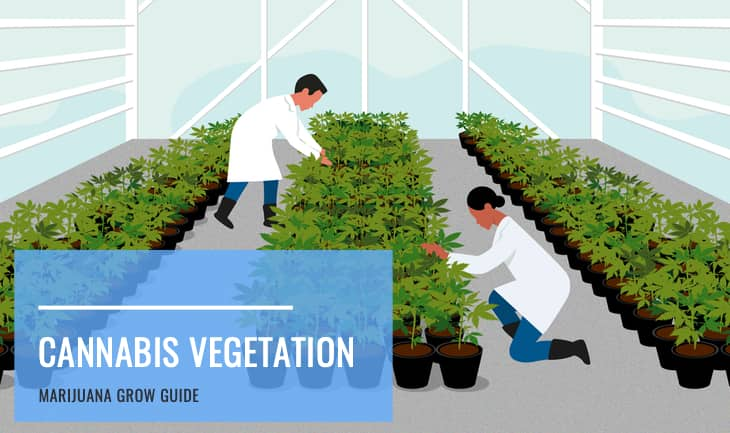
There are four main stages when growing cannabis: germination (takes 5–10 days), seedling stage (around 2-4 weeks), vegetative (around 3-15 weeks), and flowering (8-11 weeks). This article will explore the vegetative stage more briefly. During this time, cannabis plants will begin to establish elaborate root systems to help soak up nutrients from the soil. Will start the development of fuller leaves to help prepare the plants for the flowering stage, where the buds will start to show.
The vegetative growth stage
The cannabis plants begin to establish a robust and elaborate root system. When this occurs, the foliage growth will start to increase rapidly, and your cannabis plants will enter what is called the ‘vegetative growth stage.’ The next stage, called flowering, will begin when the plants start receiving 12 hours of daylight and 12 hours of nighttime. So this decision, when to switch the lights, is entirely under your control. In theory, you can leave the plants in this stage as long as you want (does not apply for auto-flowering cannabis plants).
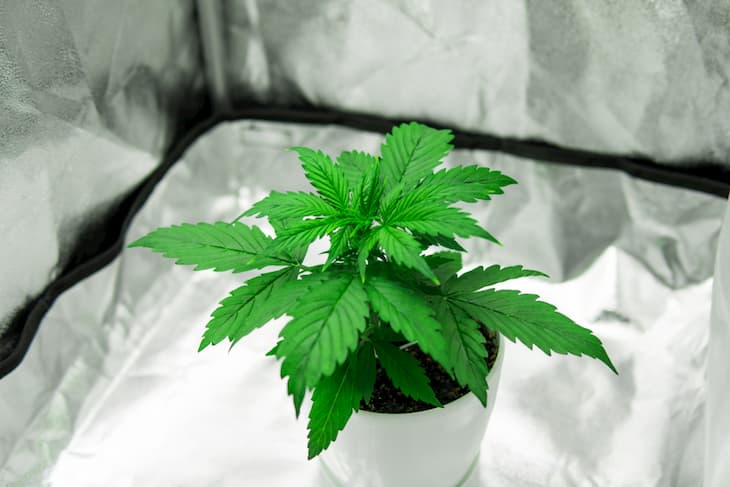
Throughout this growth stage, your marijuana plants will often develop at a fast pace, as well as sprouting thick branches full of stems and leaves. The cannabis plants must receive sufficient light, nutrients, and CO2 during vegetative growth. With optimal growing conditions met, you can expect to roughly see around ½ – 2 inches of growth per day.
Optimal conditions for the healthy growth
First of all, after few weeks in this growth stage, lights should be adjusted to the right height. Usually, recommended height for HPS 600W is between 18-20 inches (45-50cm); HPS 1000W: 30-38 inches (76-96cm) and LED grow lights: 12-16 inches (30-40cm). If you hang it too close, you might burn your plants (or enforce cannabis foxtails), and if too far away – you will lose efficiency. If you plan to grow your plants around 50 inches (130cm) tall, consider adjusting the distance from this point straight away, and later you can change if needed.
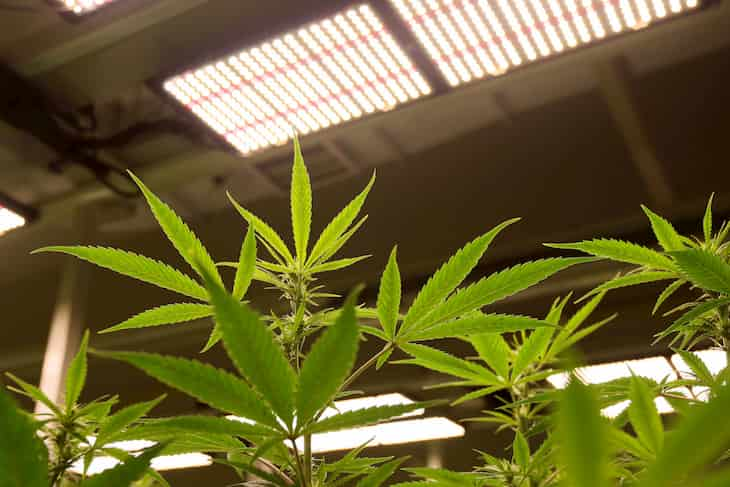
During the first few weeks in the vegetative stage, increase the wattage of the lights gradually. Don’t run the lights at maximum from the beginning. It will be too stressful for the plants.
The ideal air temperature is between 77-80°F (25-27°C), but it might differ slightly depending on the cannabis strain. Make sure the fresh air intake and extraction are working perfectly. Fresh air brings CO2 needed. The CO2 amount in the air is different in all countries, but the global average is around 410 ppm. And sadly, it’s rising yearly. More experienced growers are using equipment to increase levels of CO2 in grow rooms. It’s advantageous when you want to exploit the most powerful grow lights to the full. But it’s not as easy as it might sound. Depending on the CO2 levels, the air temperature has to be adjusted slightly. Nonetheless, some CO2 equipment raises the humidity levels, which you want to avoid happening in the flowering stage, etc.
How long to vegetate?
Usually, growers keep cannabis plants in vegetation between 3 – 5 weeks and some even 15. The longer you keep – the bigger and stronger the plants will grow. Also, you can take your time to shape your trees as you wish, even similar to bonsai (using the Low-Stress Training technique). If you think doing so, consider transplanting your plants into bigger pots to support the rapid growth.
Keep in mind that bigger/stronger plants do not necessarily mean that they will deliver a more significant yield. The major yield factor is energy coming from the lights. In most basic form, 1 watt might deliver 0.035oz (1gram) of a dried product if the whole growing process goes smooth. Growers report even greater numbers with the newest LED lights, close to 0.057-0.06 oz (1.6-1.7g) per watt.
The importance of photosynthesis
A universally necessary process which we know as photosynthesis, occurs during the vegetative growth stage. This process will start to intensify when the leaves of the cannabis plant start to expand and grow.
A pigment named chlorophyll responsible for a lot of light absorption will convert a mixture of CO2, water, and energy absorbed from light into plant-friendly oxygen and carbohydrate food to assist the cannabis plant’s vegetative growth stage.
For photosynthesis to occur effectively, the leaves of the cannabis plants must be kept relatively moist. That’s why keeping the humidity 65-75% in the air is recommended during this stage.
Minute pores on the underside of the leaf known as stomata will phase between being closed and open to prevent the cannabis plant from becoming dehydrated or holding too much water. When the stomata open, they allow for any excess plant waste or water to be excreted.
It is vitally important that you keep the stomata of the cannabis plants clean throughout the vegetative growth stage to prevent any dust or dirt from clogging up your marijuana plant’s stomata, preventing them from being able to breathe. By doing this, you can easily help maximize the process of photosynthesis, making for a much more rigorous growth-orientated process.
The importance of light
In order to keep your marijuana plants in vegetation phase, you have to track how much time the plant remains in darkness every day.
In theory, exposing cannabis plants to less than 11 hours of darkness per day will help your marijuana plants remain in their vegetative stage and stay there for as long as you wish. Usually, growers make 18 hours of daylight and 6 hours of nighttime or even keep the lights on for 24 hours non-stop (They say that the plants grow even quicker, but this is arguable, and what you will get is only bigger electricity bills).
Cannabis is a very sensitive plant – it will respond to even the slightest environmental change. So when you decide to go to the flowering stage, you just need to switch 12 hours of daytime and 12 hours of nighttime. In theory, you can revert the process backward, but the plant will get enormous amounts of stress and might never be healthy again.
Indoor grow lights
There is a wide range of indoor grow lights to choose from when growing cannabis plants indoors. Some of these include:

- High-Pressure Sodium Lights (HPS) – Intense lights which emit strong yellow light wavelengths to help stimulate the production of the marijuana buds. However, these tend to run very hot, so keep them at an appropriate distance from your plants, as we mentioned before. More heat – means more effort to control the write temperature. But it helps when you are in the flowering stage, and you need to keep the humidity in the air lower than 55%. Bulbs are so hot that they dry the air rapidly.
- Metal Halide Lamps (MH) – Some time ago were the best choice for the cannabis vegetative stage as the light emitted from these is of the blue spectrum and will give your plants a boost over this stage. But nowadays, HPS and especially LEDs do the work perfectly during all stages.
- Full Spectrum LED Grow Lights – became so advanced that they are currently the best choice throughout the growing cycle. Growers are reporting much bigger yields compared to HPS lights. They never get too hot: usually, they reach a maximum of 130°F (55°C), and most of them even lower. But at the same time, the air humidity may rise to critical levels, so a good dehumidifier is a must during the flowering stage.
Pruning cannabis plants
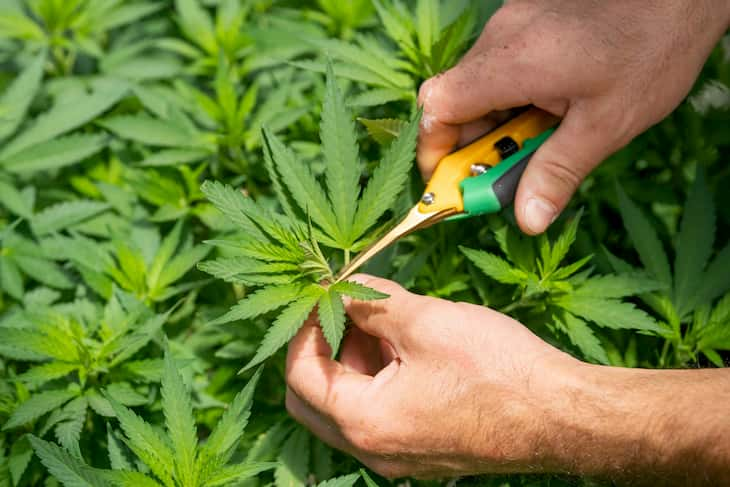
The vegetative stage is where the cannabis plant will start to take all of its shapes and form intricate root systems. It is not necessarily required to prune cannabis plants. However, the uneven shape the plant can potentially grow in can lead to an uneven distribution of light throughout the plant. Some areas will not get the optimal amount of light required to stimulate growth, and some plant’s parts may become too heavy. In the end, if done right, many experienced growers believe you can significantly increase yield.
What is pruning?
In the most basic form, pruning is cutting off shoots of growth from your plant using scissors (special ones and new ones (or sterile cleaned) – you don’t want to spread the infection and harm the pants). It should be done in the vegetative stage when the plant is well-established and reached 12 inches (around 30 centimeters) tall with several sets of leaves and not later than a couple of weeks until the flowering stage. Because cannabis is a very sensitive plant and pruning causes stress, so they need time to recover. Doing so in the flowering stage could lower the yield or even worse. Let’s begin with the types of pruning.
Topping the cannabis plant
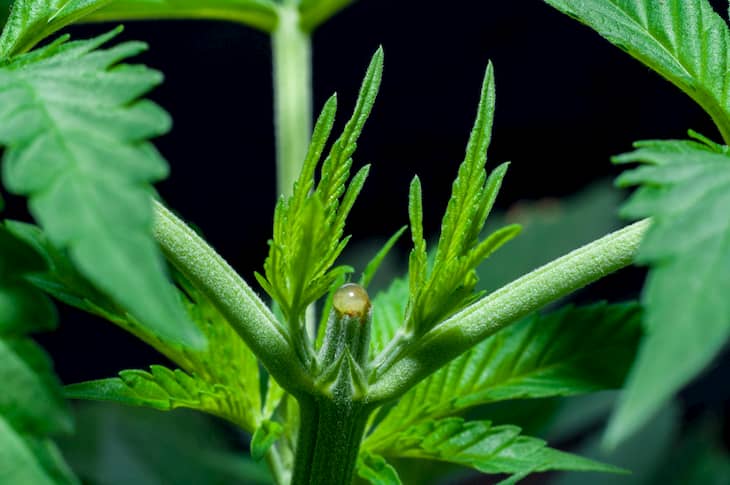
Topping is cutting off the plant’s top at the end of the main stalk. When you do it, the plant’s main stalk will stop growing upwards, and the axial branches will form and grow two new limbs that ultimately spread outwards instead (potential two new colas). You should do it when the main stalk reaches the desired height.
You even can do the same to lower branchers you plan to grow. Every time you cut off the top, you transmit the growth from that branch to the lower ones. By doing so, many experienced growers manage to shape the cannabis as they wish. But the more you want to shape it, the more time you will need to stay in vegetation. You can’t do it all in one go, as it would be too stressful for the plant. Our advice would be to learn it slowly. Begin with just topping the main stalk and see what you get at the end of the flowering. You will get a better understanding after every yield.
Removing unneeded branches
Some might say that nothing is unneeded on the plant. And they might not be wrong, but for the maximum yield, you would want to clean the lower branches that you see later on will get less and less light as the plant grows. It will also help to increase the airflow and minimize the risk of mold. You should count yourself how many upper main branches (that will grow into main colas) to leave and what’s left might be cut off. But consider leaving at least 4 main branches.
Lollipopping cannabis

In the process of lollipopping, you focus on removing all lower growth of your branches. But don’t be mistaken, you already cleared the unneeded branches before, you left the plant to rest from stress, and now you want to clean small limbs growing on the lower part of those branches. After doing so allows the plant to channel nutrition into the upper stems, leaves, and buds. Your purpose is to direct the energy and growth hormones upwards towards the buds that will most likely to thrive. Furthermore, you will achieve the maximum circulation of the air below.
It’s recommended to do a break between topping, removing unneeded branches, and lollipopping. Better give the plant to rest at least for a week without giving too much stress. Make sure it receives enough food, light, and fresh air.
Pruning the leaves
This type of pruning can be done during the flowering stage too. Recommended taking of only those large fan leaves which are blocking the light for the lower buds, especially yellow, brown, or diseased-looking ones. Or if you feel they are using too much energy, but don’t push too hard – leaves are the tool for photosynthesis. You don’t want to stress the plant in the flowering stage.
Start the flowering stage
Once you are happy with your 3 – 15 week vegetative stage and you are satisfied with the size and shape of your cannabis plants, you can begin to force the plants into their flowering stage. Keep in mind that after switching to 12/12, plants will keep growing rapidly for another 2-3 weeks. From the third/fourth week, the first tiny buds will start to appear, so the plant more and more focuses on developing them instead of growing taller.
Frequently Asked Questions (FAQs)
How long to vegetate cannabis plants?
Even if this is every grower’s choice, there are few points worth mentioning. As we wrote before in the guide, you can count that one watt of light might deliver 0.035oz (1gram) of yield. LED lights even more. So the more powerful light you have, the more plants you want under the light. For example, you use 800 watts high quality LED light. In theory, it can deliver enough energy to get 45oz (1.3kg) of yield. The plant should be big enough to produce such an amount of yield, so the vegetation might take even 10-15 weeks to grow the plant and form it in a way for the most effective light absorption. But in the same case, the yield will spread out if you grow ten smaller plants under the light. The vegetative period can be shortened to 3-4 weeks instead.
What's the recommended feeding solution pH during vegetative stage?
Cannabis plants like slightly acidic growing mediums. Optimally, keep it between 5.8 – 6.0 during the vegetative stage. If the pH is significantly lower or higher, cannabis cannot absorb nutrients (“nutrient lockout”) even if there is enough in the growing medium. If it happens, you should flush the soil/medium using a significant amount of water with perfect pH. Also, many nutrient companies have a product called “Enzyme” that helps get rid of old damaged roots and accelerate chemical reactions.
What's recommended nighttime temperature during the cannabis vegetative stage?
Keep your cannabis plants at 36 – 37.5°F (2-3°C) lower temperatures than during the daytime (when the lights are on) through the whole vegetation process. They will love it. For example, if your daytime air temperature is 79 °F (26°C), then during the night time try to keep it around 74°F (23°C). Some growers even try to minimize the difference between temperatures during the day and night.
What's Low Stress Training technique?
Low-stress training is a technique for forming a plant’s shape using small ropes or wires to produce more yield. The idea is to pull down the plant’s top in different directions so that it stays below other smaller branches, which from that point will start growing up and forming bigger buds.


